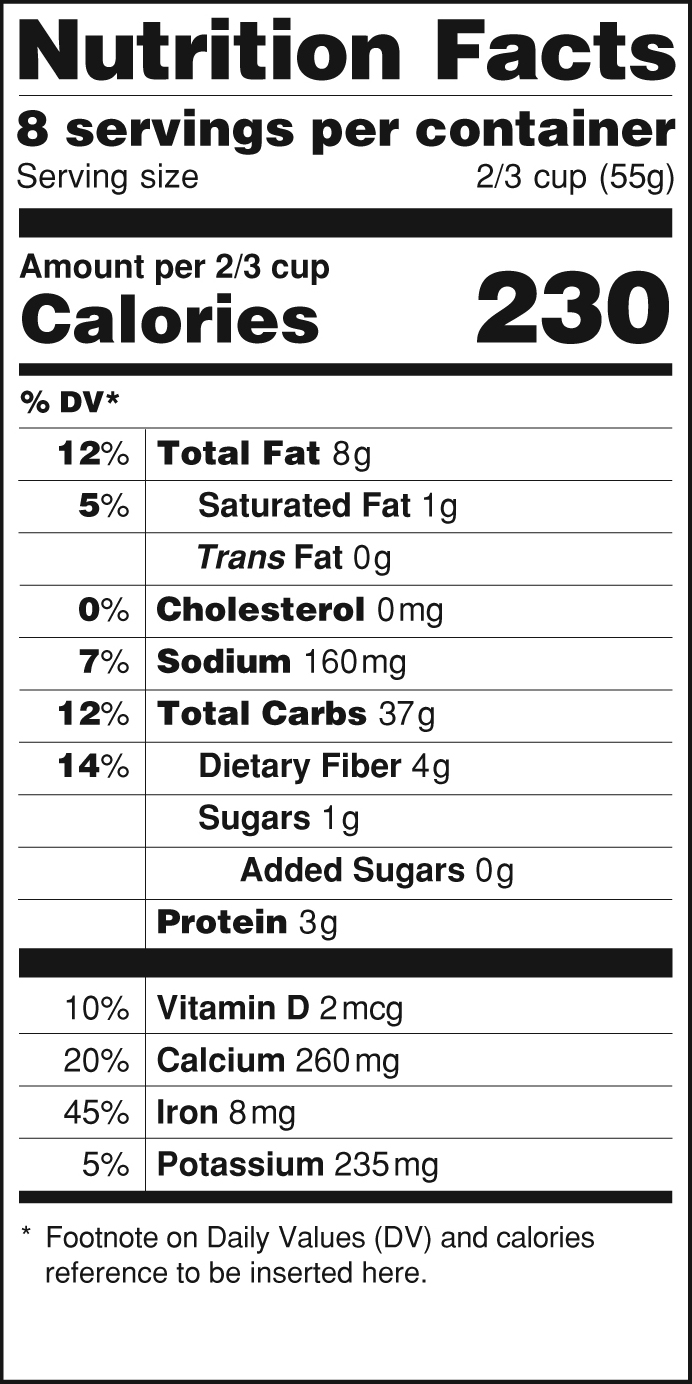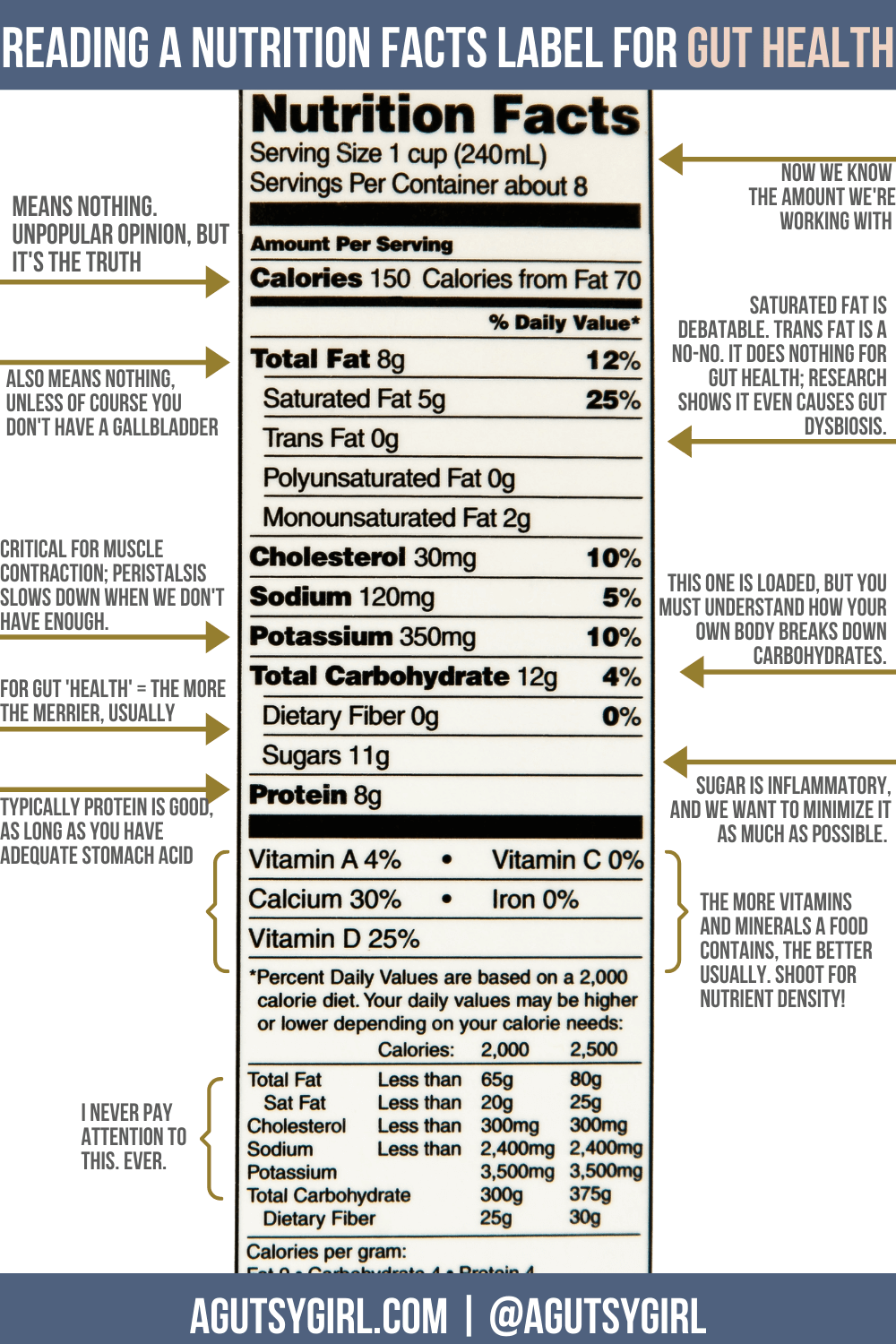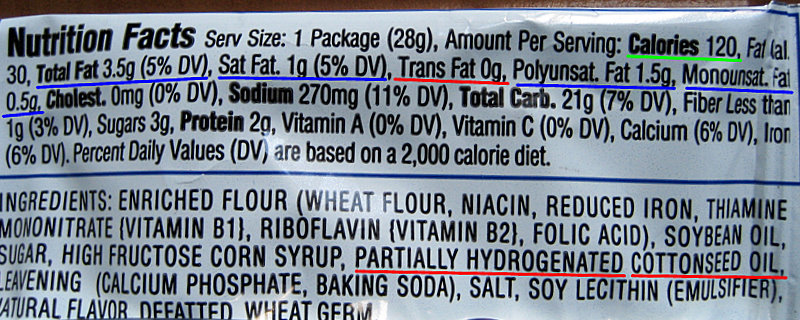43 how to read fats on food labels
PDF How to Read the Food Label - Risk Services The percentages help you find foods high in good nutrients and low in nutrients you want to avoid. If the value is 20% or more, it's considered high. If it's 5% or less, it's low. Total fat. This tells you how much fat is in one serving. A . low-fat food has 3 grams (g) or less of total fat per serving. Saturated fat and trans fat Dietary Recommendations for Healthy Children | American Heart ... Look for “whole grain” as the first ingredient on the food label and make at least half your grain servings whole grain. Recommended grain intake ranges from 2 oz./day for a one-year-old to 7 oz./day for a 14–18-year-old boy.
How to Read Nutrition Labels: 101 - Basic This means if the label says the food has 10% DV for fat, the serving of that food is 10% of the fat in the diet of a person eating 2,000 calories a day. These percentages aren't always relevant to athletes who often have higher energy and nutrient needs or have different macronutrient intakes based on their individual goals.

How to read fats on food labels
How to Read Nutrition Facts Label - Food Network Bottom line: When looking at the fat breakdown of the food, aim for those with no trans fat, a minimal amount of saturated fat, and more mono- and poly-unsaturated fats to promote heart health. Sodium Easy Guide to Understanding Food Labels When You Have High ... - MyDoc 1. Choose products low in saturated fat, trans fat and cholesterol. When shopping for food, use the nutrition information panel to compare and choose products with lower fat, saturated fat and cholesterol content. Saturated fat is a type of fat that raises your total and LDL cholesterol and risk of heart disease, so intake should be limited. Food energy - Wikipedia Many governments require food manufacturers to label the energy content of their products, to help consumers control their energy intake. To facilitate evaluation by consumers, food energy values (and other nutritional properties) in package labels or tables are often quoted for convenient amounts of the food, rather than per gram or kilogram; such as in "calories per serving" or "kcal per 100 ...
How to read fats on food labels. How to Read a Nutrition Facts Label - Everyday Health For trans fats, nutrition labels are tricky. "The nutrition facts label can have 0 g listed next to trans fat, as long as the product has less than 0.5 g of trans fat per serving," says ... How to read food labels: MedlinePlus Medical Encyclopedia This number helps determine how foods affect your weight. The total carbs (carbohydrates) are listed in bold letters to stand out and are measured in grams (g). Sugar, starch, and dietary fiber make up the total carbs on the label. Sugar is listed separately. All of these carbs except fiber can raise your blood sugar. PDF How Do I Understand the "Nutrition Facts" Label? Nutrition Facts label and ingredient list. When you go grocery shopping, take time to read the Nutrition Facts labels on the foods you purchase. Compare the nutrients and calories in one food to those in another. The information may surprise you. Make sure you aren't buying foods high in calories, saturated fat, trans fat, sodium and added ... Food Label Detective: How to Spot the Good Fats - The Dr. Oz Show Bad. All fats are not created equal. Dietary fat can be broken down into the "good," monounsaturated fat and polyunsaturated fat, and the "bad," trans fat and saturated fat. Good fats are a necessary part of a healthy, well-balanced diet. Monounsaturated fats are found primarily in plant-based oils like olive and canola, and nuts and seeds.
How To Read Food Labels - Fit Me Solution The Daily Value for iron is 18 milligrams, so 1 milligram of iron is enough to take notice of: it is more than 5 percent. But because the current Daily Value for calcium on food labels is 1000 milligrams (and the proposed is 1300), 1 milligram of calcium is a negligible amount. Reading food labels shouldn't be complicated. Here's how to understand ... Health Canada. On June 30, Health Canada announced new nutrition labelling regulations that will require prepackaged foods high in saturated fat, sugars and/or sodium to display a front-of-package ... Food Labels: Fat & Cholesterol | Home & Garden Information Center The 2015 Dietary Guidelines for Americans recommends the following intakes of fat and cholesterol every day: total fat—20 to 35% of calories, depending on age and gender (65 grams for the 2,000-calorie intake level used in the Daily Value)*. saturated fat—less than 10% of calories**. trans fat— keep as low as possible. How to Read the Nutrition Facts Label on Packaged Foods Sodium. Many people get far too much salt, or sodium. Most of it is in packaged foods and restaurant items. Limit salt to 2,300 milligrams (about 1 teaspoon) daily. If you have high blood pressure ...
Understanding Ingredients on Food Labels | American Heart ... There are many terms used for sugar on food labels. You might see sugar listed as the fourth ingredient in a product and think it’s not so bad. But sugar can also be listed as high-fructose corn syrup or corn syrup, agave nectar, barley malt syrup or dehydrated cane juice, to name just a few. Read more about sugar and sweeteners. safefood | How to read food labels How do I know if a food is low, medium or high in fat, saturated fat, sugar and salt? Some labels use colour coding to show at a glance if a food is high, medium or low in fat, saturated fat, sugar and salt. Low (green) - the best choice Medium (amber) - okay most of the time High (red) - only choose occasionally. If the label isn't colour ... How to Read Nutrition Facts Labels the Right Way - GoodRx However, foods that contain less than 0.5 g per serving are allowed to list the trans fats as 0 g on a nutrition label, so consumption of these fats is still possible. Foods that may contain small amounts of trans fats include: Packaged baked goods. Ready-to-eat frozen meals. Refrigerated doughs. Fried foods. Margarine. Shortening How to Read Food Labels for Fats and Oils A Note on Ingredient Lists. Fats and oils can come from many sources, like animal fats, fish, seeds, plants, and nuts. Reading the ingredient lists on products will reveal the source of the fat. For oils and fats ingredient lists, fats and oils are referred to by their common names (e.g., "beef fat," "cottonseed oil").
Fat Content on Food Labels - Reading Between the Lines The Mayo Foundation continued, "Still, you may be able to tell if a product contains trans fat, even if it's not directly listed on the food label. Look for the words ' hydrogenated ' or 'partially hydrogenated' in the list of ingredients. These terms indicate that the product contains trans fat. However, you won't be able to tell ...
How to Read Food Labels Without Being Tricked - Healthline Still, processed foods that are labeled low-carb are usually still processed junk foods, similar to processed low-fat foods. Made with whole grains. The product may contain very little whole ...
How To Read A Food Nutrition Label | Gobble For example, the USDA recommends that most people get 1,000 mg of calcium per day. So, if a serving of food contains 100 mg of calcium, this means the serving contains 10% Daily Value of calcium. The same applies to items on the food label you may want to avoid, like fat and cholesterol. For example, 15 grams is 20% Daily Value for total fat.
3 Ways to Read Nutrition Facts on Food Labels - wikiHow The nutritional facts that are listed on food labels contain a lot of information. To interpret what the daily values and percentages actually refer to, start by checking the serving size listed at the top of the label. ... Read the fat content in a serving and check what types of fat are present. The next row on the label is fat, and it is ...
Quick Tips for Reading the Nutrition Facts Label Nutrients to get less of include: saturated fat, trans fat, sodium, and added sugars. ... Quick Tips for Reading the Nutrition Facts Label Healthy cooking and eating start at the grocery store. Bring
How to Read Nutrition Labels: Fat Content, Carbs & What To Look For Total Fat. Nutrition labels are required to include total fat, saturated fat, and trans fat. The total amount of fat in the diet is a percentage of your calorie needs. The recommendation for the typical American diet is around 30%. For someone taking in 2,000 calories, this would mean around 70 grams of total fat per day.
Understanding Food Nutrition Labels | American Heart Association Remember that the information shown in the label is based on a diet of 2,000 calories a day. You may need less or more than 2,000 calories depending upon your age, gender, activity level, and whether you're trying to lose, gain or maintain your weight. When the Nutrition Facts label says a food contains "0 g" of trans fat, but includes ...



Post a Comment for "43 how to read fats on food labels"